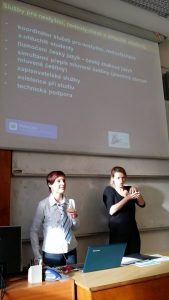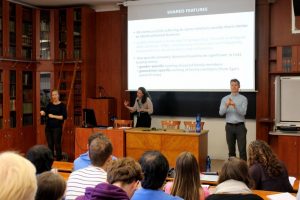Service Description
 Interpreting is used primarily by prelingually Deaf students and teachers who prefer to communicate in the Czech Sign Language.
Interpreting is used primarily by prelingually Deaf students and teachers who prefer to communicate in the Czech Sign Language.
The interpreter transfers all utterances from Czech to the Czech Sign Language and vice versa. The interpreting is mostly simultaneous. When interpreting in the class, the interpreter usually stands/sits next to the lecturer in order to enable the Deaf student to see well both the interpreter and the speaker.
The interpreter shall abide by the Internal IDS Rules for Provision of Services to CUFA’s Deaf, Hard of Hearing and Deafened Students.
The interpreter is present at regular seminars and lectures listed in the timetable, lectures and seminars beyond the fixed timetable, special events within the classes (guest, excursion etc.), tests, matriculations, graduations, individual tutorials, dealings with the Faculty’s authorities and other activities related to studies at CUFA.
The interpreter shall communicate both with the teacher and the student to whom the service is provided; in particular, they are advised to ask for feedback as to whether the course and form of the interpreting is convenient, or what could be altered.
Interpreting between the Czech language and the Czech Sign Language has been a part of the Deaf Studies programme since its establishment in 1998.
Up-to-date information about the interpreters currently cooperating with the Institute of Deaf Studies, CUFA may be found here.
Why do we provide the service? Most of our Deaf students’ and teachers’ first language is the Czech Sign Language, with Czech being only the second one. Although the ability to study from texts written in Czech (but also in English, German etc.) is essential for everybody and in no way does IDS underestimate its importance, for the Deaf the most natural and efficient means of communication in the classes as well as in many other activities related to studies is their first language: Czech Sign Language. Therefore, interpreting between Czech and the Czech Sign Language is the prerequisite for the Deaf students’ and teachers’ involvement in the education process and in the academic life in general
 Ordering interpreting
Ordering interpreting
Comments on ordering interpreting:
One orderer may order either the service of interpreting or transcription. In the event of multiple orderers per group/event, the interpreting and transcription may take place parallelly (see the photo: the speaker in white is speaking into a microphone, which enables listening via an induction loop, the interpreter in black is interpreting simultaneously into the Czech Sign Language and, outside of the picture, the speech is being transcribed simultaneously into the Czech language onto a screen). Interpreting/transcription are almost always supplemented with the note-taking service.
Interpreting may be ordered even for a class/event held not in spoken Czech or in the Czech Sign Language but in another (foreign) spoken language (English, Dutch, etc.) or another (foreign) sign language (American, British, German…). In most such cases Czech–English, Czech Sign Language – American Sign Language interpreting etc. also needs to be arranged. This communication situation is rather complex and, therefore, requires more thorough preparation.

Complex interpreting situation (photo from the Summer School of Sign Language Linguistics 2014): the speaker in the middle uses spoken Czech, with the simultaneous interpreter on the left interpreting into CzSL and the simultaneous interpreter on the right interpreting into IS from English received into earphones from a simultaneous interpreter interpreting outside of the picture from spoken Czech into spoken English.
As an alternative for a class/event in spoken English, IDS also offers (on a trial basis for the moment) direct interpreting between English and the Czech Sign Language, without mediation of Czech.